Study on Microstructure and Texture of Fe-3%Si Ultra-Thin Ribbons Prepared by Planar Flow Casting
Abstract
:1. Introduction
2. Materials and Methods
2.1. Experimental Materials and Characterization Methods
2.2. Finite Element Simulation of Crystal Plasticity
3. Results
3.1. Microstructure and Texture of Planar-Flow-Casted Ribbons
3.2. Microstructure and Texture Changes during the Direct Annealing of Planar-Flow-Casted Ribbons
3.3. Effect of Temper Rolling and Annealing on the Microstructure and Texture of Planar-Flow-Casted Ribbons
3.4. Differential Analysis of Grain Deformation Stored Energy with Different Characteristic Orientations
4. Conclusions
- (1)
- The Fe-3% Si ultra-thin non-oriented silicon steel ribbons prepared by planar flow casting (PFC) exhibit a significant columnar crystal structure, with {001}-oriented grains constituting over 30%. After annealing, the average grain size exhibits a slight increment with the rising annealing temperature. The grains of different orientations grow evenly, the proportion of grains of each orientation is basically unchanged, and the {001} favorable texture is well preserved.
- (2)
- Uneven grain growth was observed when the planar-flow-casted (PFC) ribbons underwent annealing following temper rolling with 7% reduction. The growth capability of {001}-oriented grains surpassed that of {111}-oriented grains. The disparity in this growth capability initially increased and then decreased with rising annealing temperatures, and this difference peaked at 950 °C, leading to the highest proportion of {001} grains and the lowest proportion of {111}-oriented grains at this temperature. Following temper rolling with a 15% reduction rate and subsequent annealing, grains of each orientation exhibited significant growth at all temperatures. That is, the {001}-oriented grains did not have a pronounced growth advantage better than others, and the {001} texture is weakened while the {111} texture is strengthened. Overall, for the synergistic optimization of microstructure and texture, rolling at a 7% reduction rate followed by annealing at 950 °C in a hydrogen atmosphere is most advantageous.
- (3)
- Based on crystal plasticity finite element (CPFE) simulations, it was found that the deformation stored energy of {001}- and Goss-oriented grains is lower than that of {111}-oriented grains at various reduction rates. At 7% reduction, the deformation stored energy accumulation of {001} grains is much less than that of {111} grains after rolling, and this marked stored energy difference contributes to the strong growth advantage of {001} grains during annealing based on SIBM mechanism.
Author Contributions
Funding
Institutional Review Board Statement
Informed Consent Statement
Data Availability Statement
Acknowledgments
Conflicts of Interest
References
- Mao, W.M.; Yang, P. Material Principle of Electrical Steel; Higher Education Press: Beijing, China, 2013; pp. 89–90. [Google Scholar]
- Zhang, N.; Yang, P.; Mao, W.M. Effect of columnar grains on recrystallization texture evolution of Fe-3% Si electrical steel. Acta Metall. Sin. 2012, 48, 307–314. [Google Scholar] [CrossRef]
- Guthrie, R.I.L.; Isac, M.M. Continuous Casting Practices for Steel: Past, Present and Future. Metals 2022, 12, 862. [Google Scholar] [CrossRef]
- Mann, J.B.; Mohanty, D.P.; Kustas, A.B.; Stiven Puentes Rodriguez, B.; Naziru Issahaq, M.; Udupa, A.; Sugihara, T.; Trumble, K.P.; M’Saoubi, R.; Chandrasekar, S. Large-scale metal strip for power storage and energy conversion applications by machining-based deformation processing. CIRP Ann. 2023, 72, 45–48. [Google Scholar] [CrossRef]
- Wang, J.; Liu, X.; Lei, C.; Mao, X.; Liu, D.; Fan, X.; Luo, Z.; Luo, F. Core loss reduction for Fe-6.5wt%Si soft magnetic composites doped with Co element. J. Magn. Magn. Mater. 2020, 502, 166553. [Google Scholar] [CrossRef]
- Gutiérrez Castañeda, E.J.; Hernández Miranda, M.G.; Salinas Rodríguez, A.; Aguilar Carrillo, J.; Reyes Domínguez, I. An EBSD investigation on the columnar grain growth in non-oriented electrical steels assisted by strain induced boundary migration. Mater. Lett. 2019, 252, 42–46. [Google Scholar] [CrossRef]
- Kestens, L.; Jonas, J.J. Modeling texture change during the static recrystallization of interstitial free steels. Metall. Mater. Trans. A 1996, 27, 155–164. [Google Scholar] [CrossRef]
- Bennett, T.A.; Kalu, P.N.; Rollett, A.D. Strain-Induced Selective Growth in 1.5% Temper-Rolled Fe∼1%Si. Microsc. Microanal. 2011, 17, 362–367. [Google Scholar] [CrossRef]
- Ou, K.H.; Koo, Y.M.; Lee, D.N. Evolution of Textures and Microstructures in Low-Reduction Rolled and Annealed Low-Carbon Steels. Mater. Sci. Forum 2012, 715–716, 173–178. [Google Scholar]
- Kestens, L.; Jonas, J.J.; Van Houtte, P.; Aernoudt, E. Orientation selective recrystallization of nonoriented electrical steels. Metall. Mater. Trans. A 1996, 27, 2347–2358. [Google Scholar] [CrossRef]
- Murakami, K.; Tarasiuk, J.; Réglé, H.; Bacroix, B. Study of the Texture Formation during Strain Induced Boundary Migration in Electrical Steel Sheets. Mater. Sci. Forum 2009, 467–470, 893–898. [Google Scholar] [CrossRef]
- Ouyang, G.; Macziewski, C.R.; Jensen, B.; Ma, T.; Choudhary, R.; Dennis, K.; Zhou, L.; Paudyal, D.; Anderson, I.; Kramer, M.J.; et al. Effects of Solidification Cooling Rates on Microstructures and Physical Properties of Fe-6.5%Si Alloys. Acta Mater. 2021, 205, 116575. [Google Scholar] [CrossRef]
- Chen, S.-D.; Liu, X.-H.; Liu, L.-Z.; Song, M. Crystal plasticity finite element simulation of slip and deformation in ultra-thin copper strip rolling. Acta Metall. Sin. 2016, 52, 120–128. [Google Scholar] [CrossRef]
- Chen, S.-D.; Lu, R.-H.; Sun, J.; Li, J.; Zhang, K. Effect of cold rolling reduction on crystal slipping around grain boundary of rolled single layer grain ultra-thin strip. Mater. Sci. Technol. 2018, 26, 88–96. [Google Scholar] [CrossRef]
- Chen, S.-D.; Liu, X.-H.; Liu, L.-Z.; Sun, X.-K. Crystal plasticity finite element simulation of slip system evolution in pure copper foil rolling. Learn. J. Dongbei Univ. 2016, 37, 647–652. [Google Scholar]
- Chen, S.-D.; Lu, R.-H.; Sun, J.; Li, J.; Zhang, K. Simulation of effect of grain size effect on rolling deformation mechanism of copper ultra-thin strip. Trans. Nonferrous Met. Soc. China 2018, 28, 2233–2241. [Google Scholar]
- Chen, S.-D.; Lu, R.-H.; Chen, Z.-P.; Sun, J.; Li, J. Crystal plasticity modelling of slip activation and strain localization in a copper single layer crystal under foil rolling. Mater. Guide 2021, 35, 04170–04176. [Google Scholar]
- Chu, S.J.; Sheng, K.Y.; Sha, Y.H.; Chen, X. Orientation dependence of strain stored energy and its effect on recrystallization texture in non-oriented silicon steel. Mater. Eng. 2019, 47, 147–153. [Google Scholar]
- Liu, R.X.; Qi, P.; Sun, F.; Zhang, J.; Wu, G.; Wang, S.; Zhu, Z.; Wang, M.; Mao, X. High Magnetic Performance Ultra-Thin Fe-6.5Si Ribbons Fabricated by Planner Flow Casting and Annealing. J. Magn. Magn. Mater. 2024, 589, 171538. [Google Scholar] [CrossRef]
- Cheng, Y.Y.; Bao, S.; Liu, C.; Hu, J.; Xu, D.; Chang, J.; Guo, R.; Fan, X. Effect of Wheel Speed on the Microstructure and Magnetic Properties of Fe-3.0Wt%Si Non-Oriented Silicon Steel Ultra-Thin Ribbons Prepared by Planar Flow Casting. J. Mater. Res. Technol. 2024, 30, 210–2146. [Google Scholar] [CrossRef]
- Zhang, N.; Xu, J.-J.; Tu, Y.; Zhou, X.-Z.; Zhang, B.; Meng, L. Microstructure and texture evolution during temper rolling and annealing of Fe-3% Si steel sheets prepared by planar flow casting. Electrical Steel 2024, 6, 1–5. [Google Scholar]
- Tu, Y.; Meng, L.; Zhang, N.; Xu, J.-J. Evolutions of Cube ({001}<100>) and {115}<161> Orientations in Cold-Rolled Ultra-Thin Non-Oriented Silicon Steel. Materials 2023, 16, 6735. [Google Scholar] [CrossRef] [PubMed]
- Gautam, J.; Petrov, R.H.; Leunis, E.; Kestens, L.A. Strain Induced Inward Grain Growth during Recrystallisation in Steel Sheets with BCC Crystal Structure. Mater. Sci. Forum 2012, 715–716, 303–308. [Google Scholar]
- Xu, H.-J.; Xu, Y.-B.; He, Y.L.; Yue, S.; Li, J.-P. Tracing the Recrystallization of Warm Temper-Rolled Fe-6.5 Wt% Si Non-Oriented Electrical Steel Using Aquasiin Situ Ebsd Technique. J. Mater. Sci. 2020, 55, 17183–17203. [Google Scholar] [CrossRef]
- Gao, S.; Liao, H.; Yan, X.; Xie, Q.; Chang, C.; Lu, B.; Zhang, X.; Fenineche, N.; Liu, M. Magnetic and mechanical properties of additive manufactured Fe-3wt.%Si materia. J. Magn. Magn. Mater. 2023, 580, 170907. [Google Scholar] [CrossRef]
- Liang, Y.; Wang, S.; Qi, J.; Je, F.; Lin, J. Microstructure and properties of cost-effective Fe–6.5 wt % Si ribbons fabricated by melt-spinning. Scr. Mater. 2019, 163, 107–110. [Google Scholar] [CrossRef]
- Murakami, K.; Kubota, T.; Grégori, F.; Bacroix, B. The Effect of Dislocations in Grains on Texture Formation in Strain Induced Boundary Migration. Mater. Sci. Forum 2007, 558–559, 271–276. [Google Scholar]
- Bouaziz, O.; Allain, S.; Scott, C. Effect of grain and twin boundaries on the hardening mechanisms of twinning-induced plasticity steels. Scr. Mater. 2008, 58, 484–487. [Google Scholar] [CrossRef]




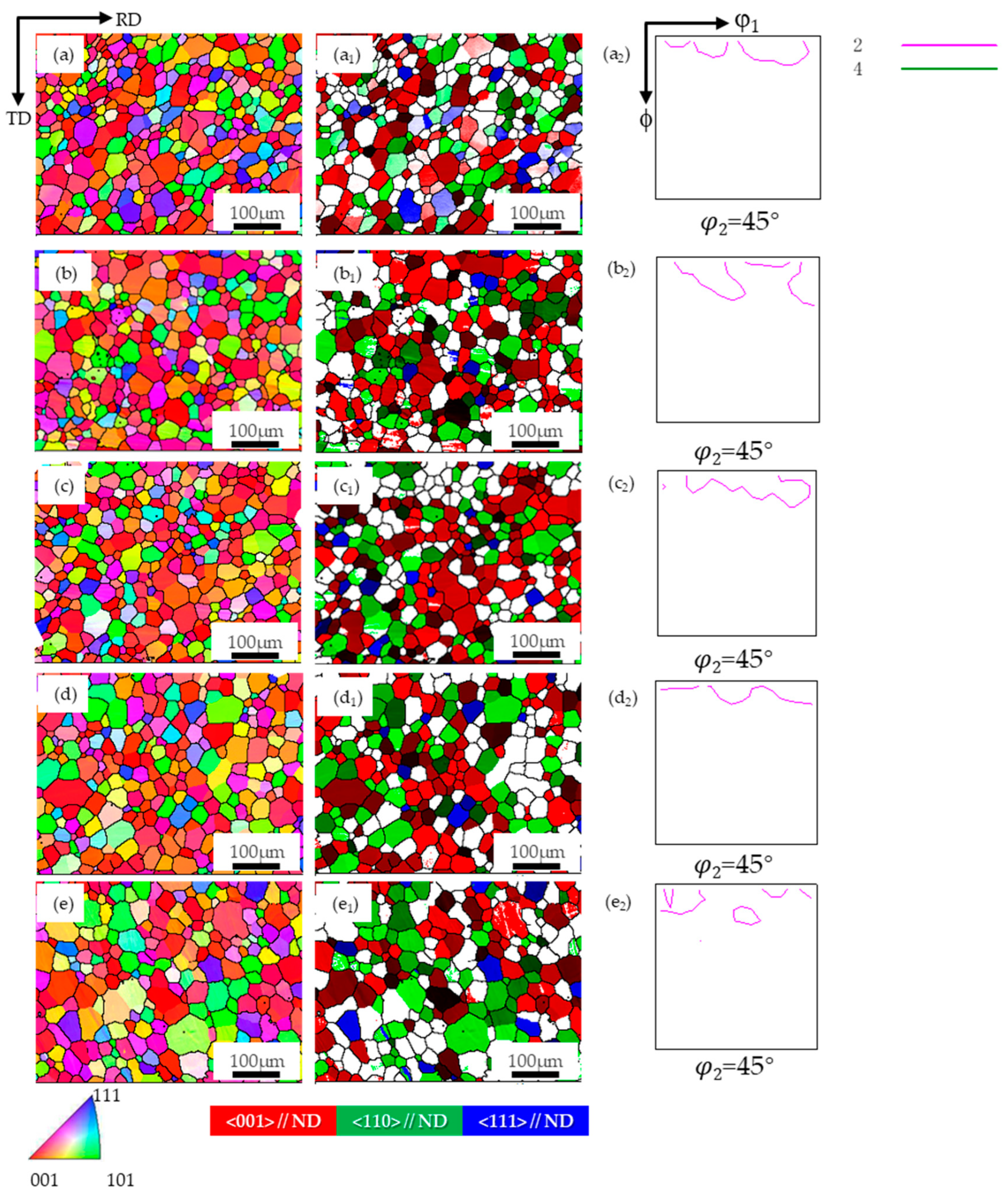
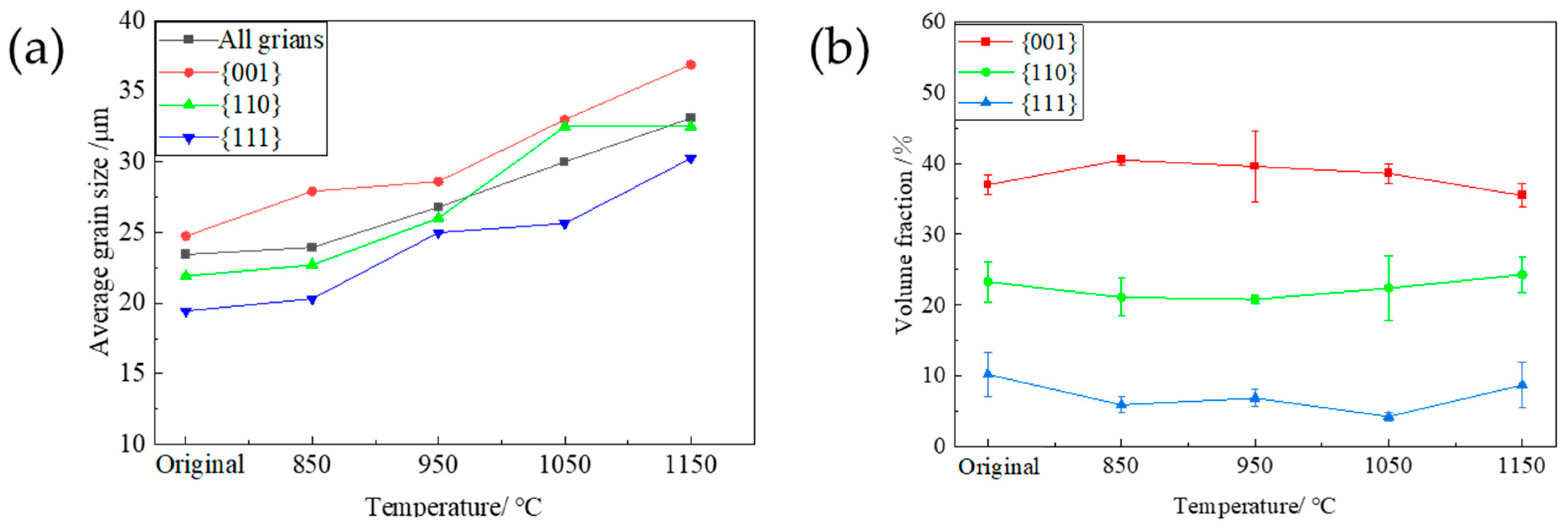
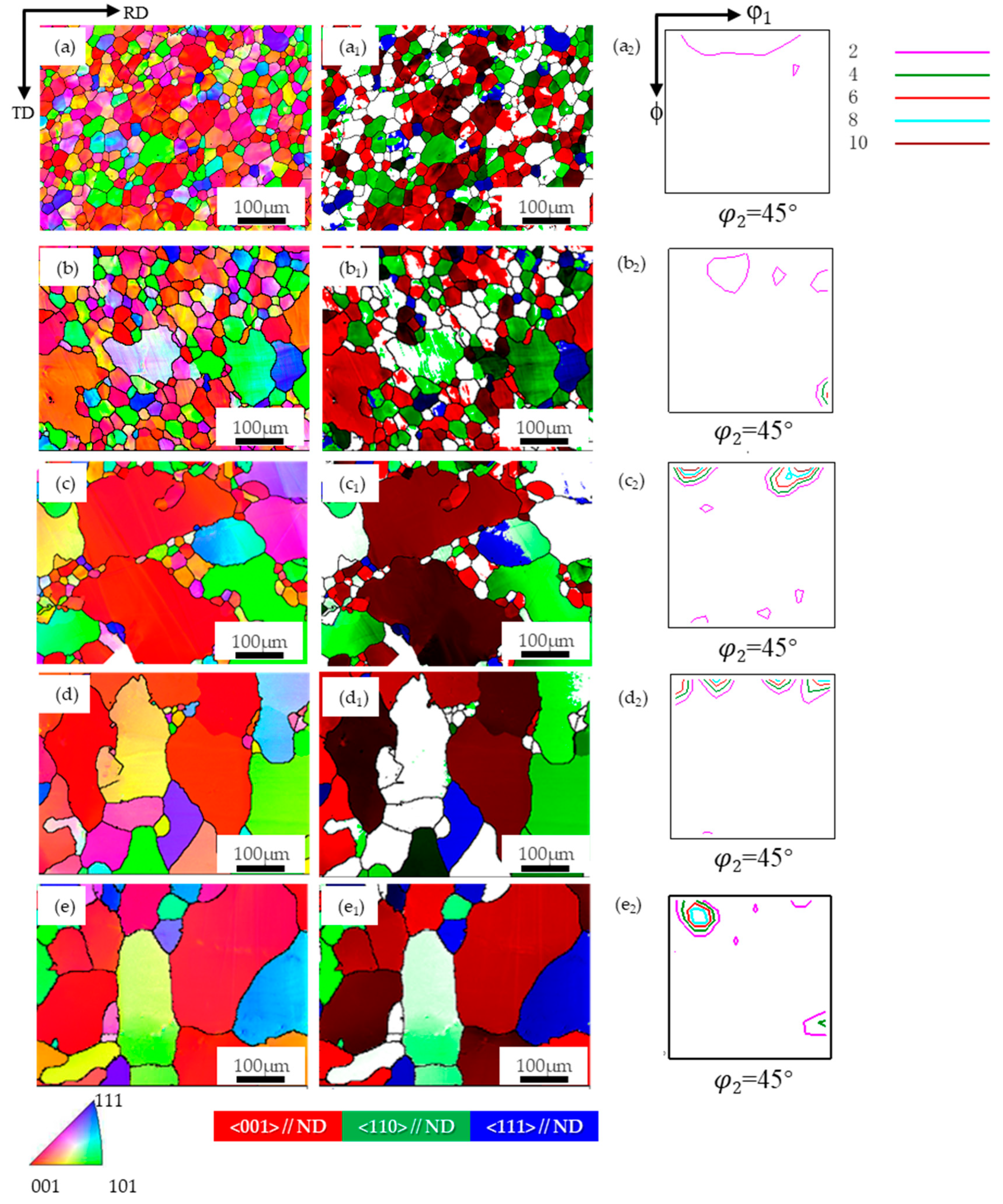
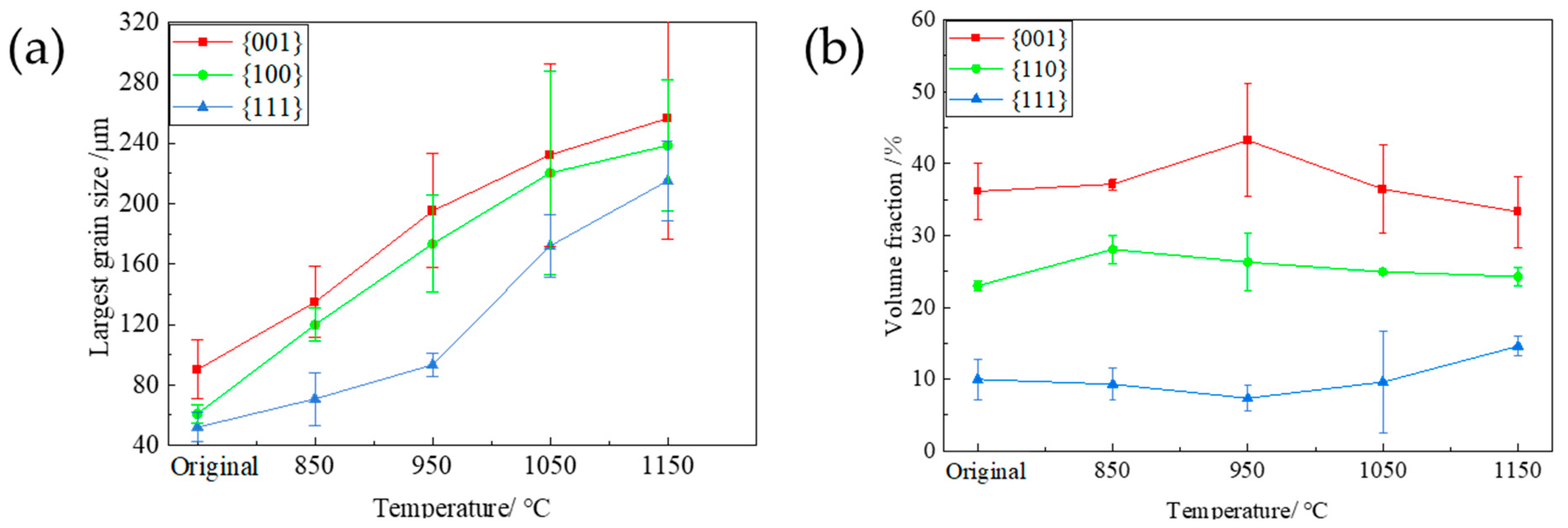
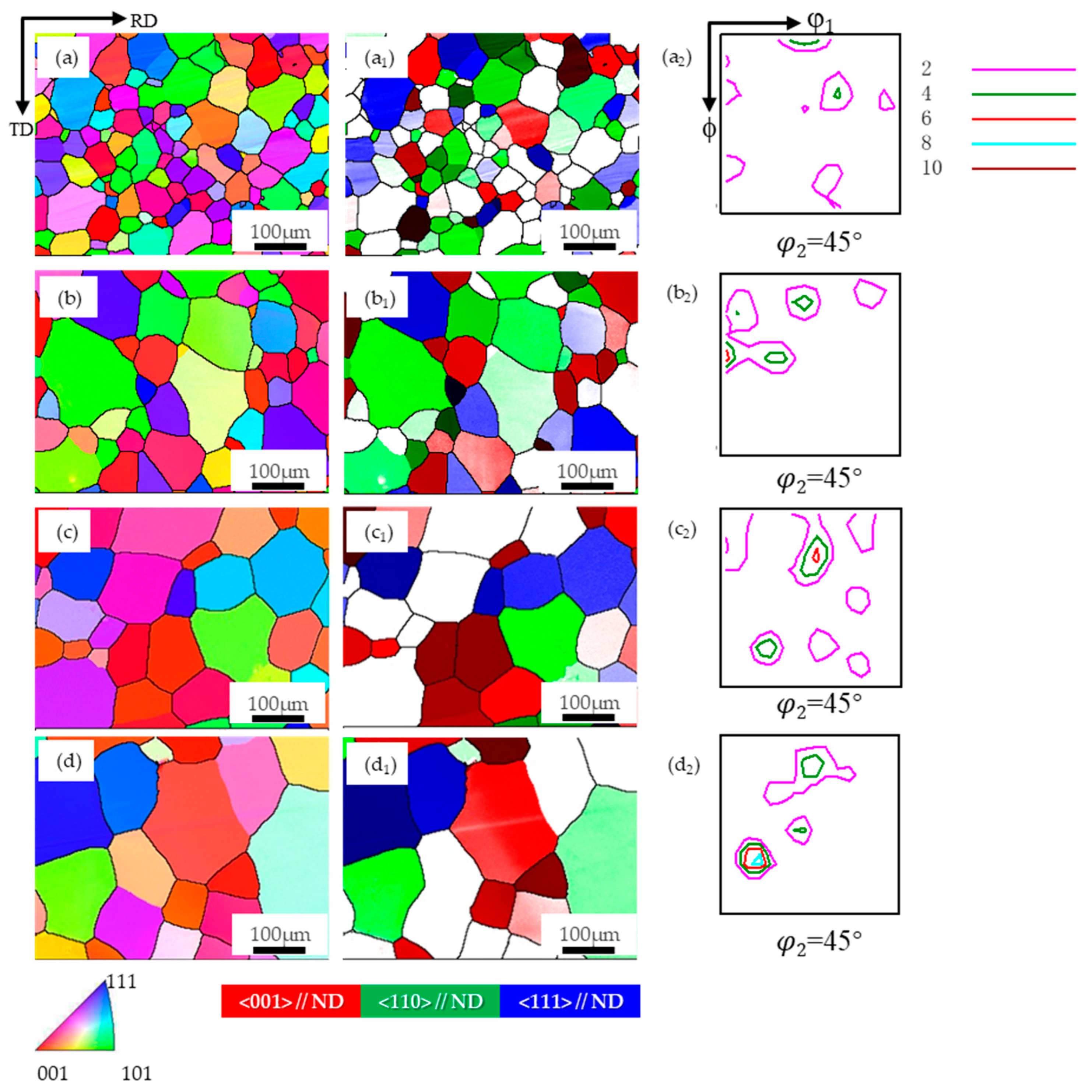
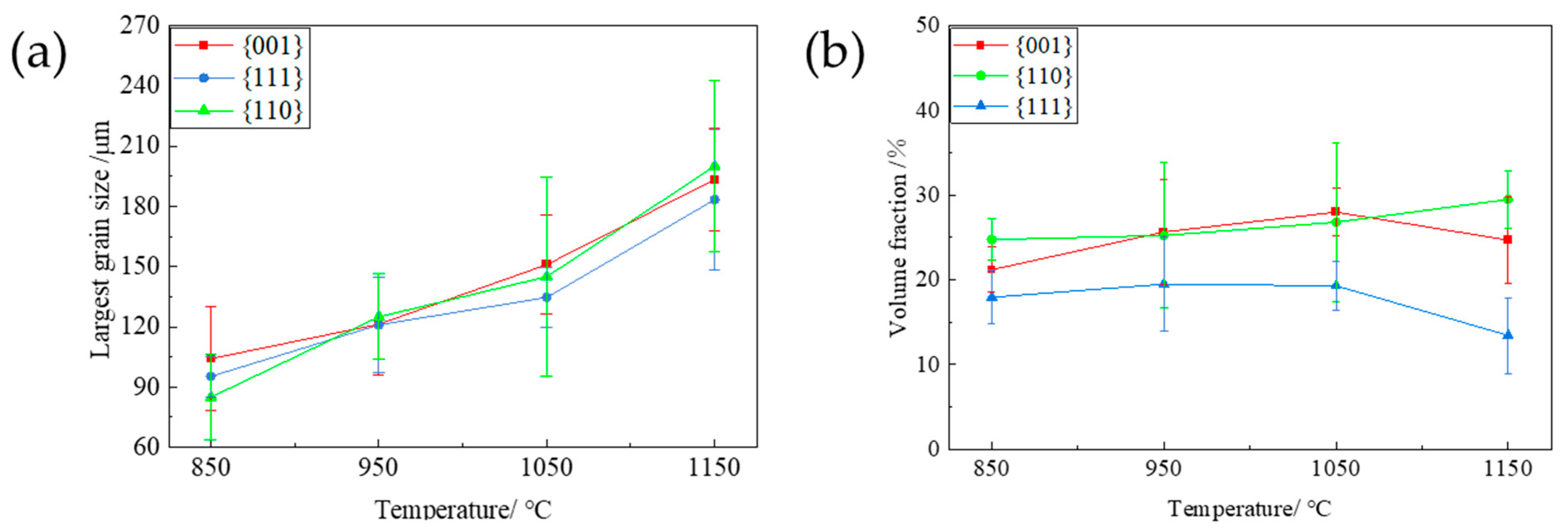


Disclaimer/Publisher’s Note: The statements, opinions and data contained in all publications are solely those of the individual author(s) and contributor(s) and not of MDPI and/or the editor(s). MDPI and/or the editor(s) disclaim responsibility for any injury to people or property resulting from any ideas, methods, instructions or products referred to in the content. |
© 2024 by the authors. Licensee MDPI, Basel, Switzerland. This article is an open access article distributed under the terms and conditions of the Creative Commons Attribution (CC BY) license (https://creativecommons.org/licenses/by/4.0/).
Share and Cite
Xu, J.; Zhang, N.; Tu, Y.; Meng, L.; Zhou, X.; Niu, C. Study on Microstructure and Texture of Fe-3%Si Ultra-Thin Ribbons Prepared by Planar Flow Casting. Materials 2024, 17, 4893. https://doi.org/10.3390/ma17194893
Xu J, Zhang N, Tu Y, Meng L, Zhou X, Niu C. Study on Microstructure and Texture of Fe-3%Si Ultra-Thin Ribbons Prepared by Planar Flow Casting. Materials. 2024; 17(19):4893. https://doi.org/10.3390/ma17194893
Chicago/Turabian StyleXu, Jiangjie, Ning Zhang, Yang Tu, Li Meng, Xiaozhou Zhou, and Chengzhou Niu. 2024. "Study on Microstructure and Texture of Fe-3%Si Ultra-Thin Ribbons Prepared by Planar Flow Casting" Materials 17, no. 19: 4893. https://doi.org/10.3390/ma17194893





